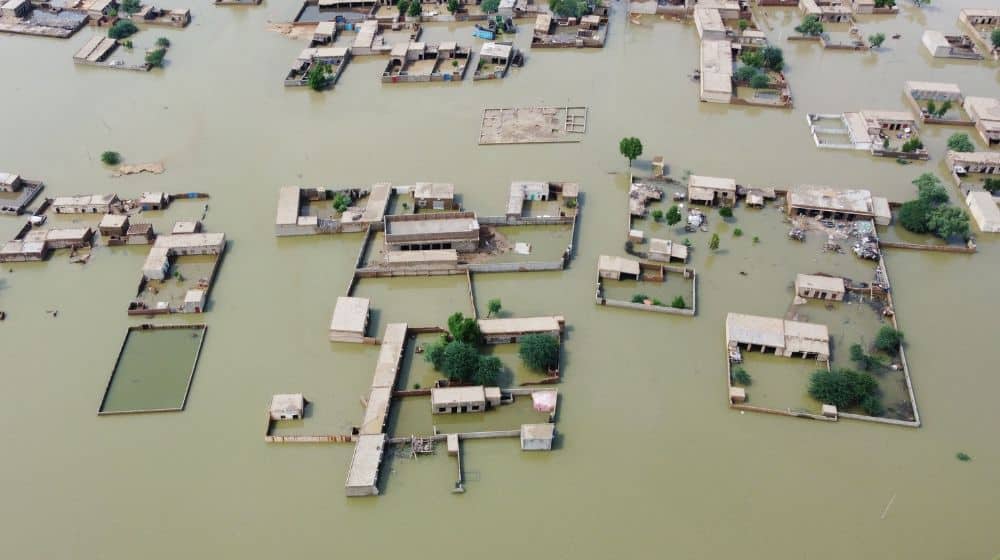
The Asian Development Bank (ADB) has warned that climate change is expected to increase the frequency and magnitude of floods and other extreme weather events in the future, and the government of Pakistan needs to be prepared in advance to mitigate the damage.
The Bank in its latest report “Applying Spatial Analysis to Assess Crop Damage a Case Study of Pakistan 2022 Floods”, stated that Pakistan is highly flood-prone and faces a growing risk of water-related disasters due to predicted impacts of climate change. It is important to plan how to use real-time crop damage assessments such as spatial analysis to plan for immediate disaster assistance and recovery efforts.
The report noted that Pakistan is ranked among the countries that are most vulnerable to climate change, especially to extreme weather events and natural hazards—the Global Climate Risk Index 2021 ranked Pakistan as the world’s 8th most vulnerable country. The country is projected to experience warming surpassing the global average and an increase in the number of days with a heat index exceeding 35C. Progressive warming and periodic heat waves will accelerate glacial melting, increase the frequency and severity of droughts, and decrease water availability for agriculture. The observed spatial and temporal variability in monsoon rainfall has further exacerbated the uncertainty in water availability and implications on food insecurity.
More than half of the country’s population depends directly or indirectly on agriculture for its livelihood, and agriculture production is highly exposed to and dependent on climate and weather events. Climate warming will intensify the existing high water demand to 60% by 2047 compared to current levels, leading to a substantial decrease in crop and livestock productivity.
During June–August 2022, torrential rains and a combination of riverine, urban, and flash flooding led to an unprecedented disaster in Pakistan. After the flood, the government conducted a PDNA with the support of ADB, the European Union, United Nations agencies, and the World Bank. National and international experts across 17 sectors have collaborated closely with federal and provincial ministries, departments, and agencies to collect data from the 94 calamity-hit districts. Partner agencies have supported the government in applying the PDNA methodology and analyzing data received from provincial and federal agencies, ministries, and departments.
The PDNA report estimates the overall economic losses from the 2022 floods at $14.9 billion. The report highlights the significant impact of the floods on the country’s agriculture sector, which is a major contributor to Pakistan’s economy. The report notes that the floods damaged 1.8 million hectares (ha) of cropland, which resulted in a loss of $3.7 billion. The data in the PDNA report are provided by the provincial crop reporting services (CRSs) using field surveys. Because CRS employees could gather only limited information on the flood extent and crop damage, PDNA partners helped validate the data using remote sensing technology. Authenticating the data on crop damage was important and was accomplished by comparing the data derived from remote sensing with data gathered on the ground in accessible areas. ADB’s remote sensing team estimated crop damage by monitoring the health of crops over a period of time.
The Bank has presented key recommendations to facilitate the use of technology to enhance crop monitoring which include: (i) increase the number of geographic information system and remote sensing specialists in relevant government agencies such as crop reporting services and statistics offices; (ii) integrate the use of spatial analysis into statistical reporting systems to improve their accuracy and timeliness. The spatial analysis can provide preliminary results that can be verified by field observations; (iii) familiarize policy makers with and enable them to interpret spatial analysis results to help them make more effective decisions. Circulate periodic spatial analysis reports among policy makers to earn their trust in the analysis; and (iv) plan policy actions for early detection of crop damage, rapid field verifications, mobilization of adequate financial and material resources, and effective communications with affected populations. Images from spatial analysis can be released through media or posted on government websites.
The Bank in another report “Regional Action on Climate Change: A Vision for the Central Asia Regional Economic Cooperation Program”, stated that ADB, in cooperation with other development partners, will further explore ways to deploy the energy transition mechanism (ETM) in the CAREC region. ETM accelerates the retirement of existing coal-fired power plants and combined heat and power coal-fired plants and pursues strategic decarbonization of the power, construction, and industrial sectors. Kazakhstan and Pakistan are finalizing a high-level assessment of existing assets suitable for ETM.
The years 2022–2023 witnessed particularly dramatic and deadly examples of climate change in the region, including devastating floods in Pakistan, severe drought in Afghanistan, floods in the People’s Republic of China, excessive heat beyond historical levels, and transboundary water issues in Central Asia. These trends and climate-linked events are sharp reminders of the long-term likelihood of even more serious impacts if steps are not taken to control carbon emissions and increase countries’ resilience, the Bank added.